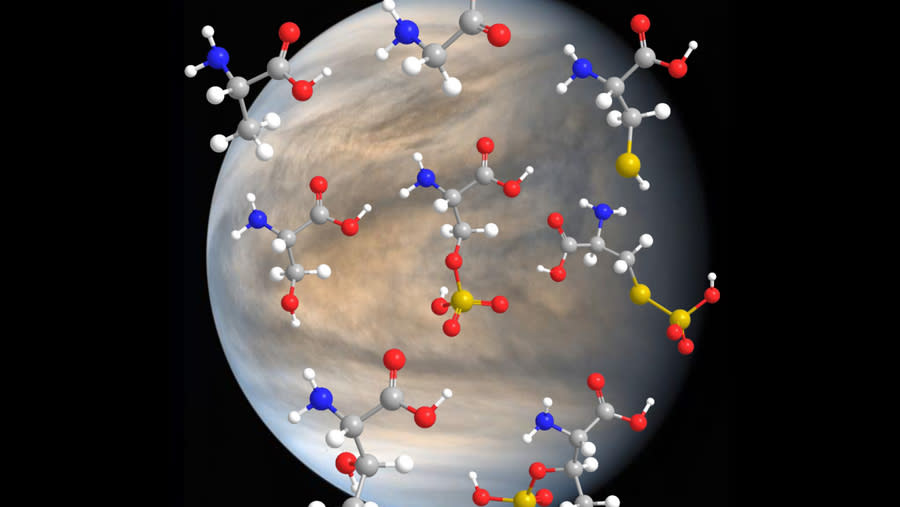Life as we know it could exist on Venus, new experiment reveals

- Oops!Something went wrong.Please try again later.
If Venus hosts lifeforms in its toxic clouds, they likely won't be deprived of amino acids, one of the essential building blocks of life (as we know it). At least, that's what scientists say is the result of a new lab experiment.
Despite being Earth's "twin," Venus sizzles at temperatures reaching hundreds of degrees and is blanketed by clouds made of corrosive sulfuric acid, a colorless, carcinogenic liquid that dissolves metals, erodes our teeth and irritates our eyes, noses and throats. As such, the rocky planet isn't considered to be much of a habitat for living organisms; it's definitely not as welcoming as Mars, Jupiter's icy moon Europa or Saturn's Enceladus seem to be. However, scientists suspect that any life that might have emerged in Venus' hellish environment could be found wafting in its noxious clouds, which are cooler than the planet's surface and could thus support some kinds of extreme lifeforms.
Along those lines, a new lab experiment, conducted by researchers at the Massachusetts Institute of Technology (MIT), found that 19 amino acids surprisingly persisted for at least a month in a sulfuric acid solution that included some water. This solution's sulfuric acid concentration was similar to what's found in Venusian clouds. The results show sulfuric acid is not universally hostile to organic chemistry we find on Earth, and suggest Venusian clouds could host at least a few of these complex, life-friendly molecules.
Related: Alien life could thrive in Venus' acidic clouds, new study hints
"It doesn't mean that life there will be the same as here. In fact, we know it can't be," Sara Seager, an astrophysicist and planetary scientist at MIT and co-author of the new study, said in a statement. "But this work advances the notion that Venus' clouds could support complex chemicals needed for life."
Early last year, Seager and her colleagues dissolved 20 "biogenic" amino acids — molecules that are essential to all lifeforms on Earth thanks to their role in breaking down food, generating energy, building muscle and more — in vials of sulfuric acid mixed with water to mimic the environment found in Venus' clouds. For four weeks, her team analyzed the structure of these amino acids, which included glycine, histidine and arginine, among others, and found the molecular "backbone" of 19 of the molecules remained intact despite the highly acidic environment.
"People have this perception that concentrated sulfuric acid is an extremely aggressive solvent that will chop everything to pieces," said study co-author Janusz Petkowski of MIT's Department of Earth, Atmospheric and Planetary Sciences (EAPS). "But we are finding this is not necessarily true."
The experiment was ended after four weeks due to no further signs of activity.
"Just showing that this backbone is stable in sulfuric acid doesn't mean there is life on Venus," said Maxwell Seager, an undergraduate student at the Worcester Polytechnic Institute in Massachusetts, who led the study. "But if we had shown that this backbone was compromised, then there would be no chance of life as we know it."
Nine of the 20 amino acids the team tested are also found in meteorites, suggesting meteor impacts may have supplied those molecules to Venus too, the researchers say.
Related Stories:
— Life on Venus? Intriguing molecule phosphine spotted in planet's clouds again
— If Venus had Earth-like plate tectonics in its distant past, did it have life too?
— 1st private mission to Venus will search for alien life in clouds of sulfuric acid
Seeking out molecules such as these in the thick clouds of Venus is the focus of a highly anticipated, privately-funded mission to the planet next January. Called the Venus Life Finder, this mission will send a spacecraft named Photon to fly past Venus and drop a small, single-instrument probe into the planet's atmosphere. The parachute-less probe is designed to detect organic compounds as it falls through the skies and radio data back to Earth before getting destroyed, ultimately helping to assess the habitability potential of Venus.
"I think we are just more happy than anything that this latest result adds one more 'yes' for the possibility of life on Venus," said Sara Seager, who's also the mission's principal investigator.
The team's results were published on March 18 in the journal Astrobiology.

